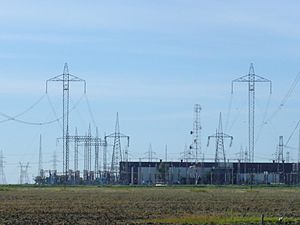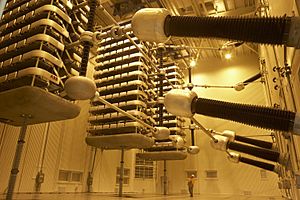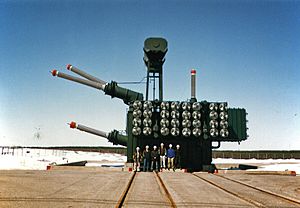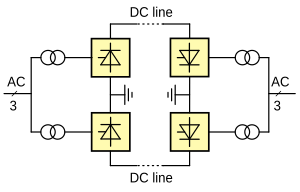High-voltage direct current facts for kids

A high-voltage direct current (HVDC) system is a special way to send electricity over long distances. It uses direct electric current (DC), which means the electricity flows in only one direction. This method is often better and more efficient than using alternating current (AC) for very long power lines.
Contents
How HVDC Started
HVDC technology was first shown in Germany way back in 1882. Over time, countries like Sweden and Nazi Germany worked to make it even better in the 1930s. The first times it was used for real, commercial power lines were in the Soviet Union and Sweden in 1951.
How HVDC Works
Converter Stations
At each end of an HVDC power line, there's a special building called a converter station. These stations are super important because they change the type of electricity.
- One station changes AC electricity (like what comes from power plants) into DC electricity to send it down the line.
- The other station changes the DC electricity back into AC so it can be used in homes and businesses.
There are two main types of converters:
- Line-commutated converters (LCC)
- Voltage-source converters (VSC)
Converter Transformer
Inside the converter station, there's a big transformer. This device helps to make sure the electricity is at the correct voltage level before it gets changed from AC to DC, or vice versa. It also helps to keep the HVDC system separate from the regular AC power grid.
Cleaning Up the Power
Sometimes, when electricity is changed from AC to DC, it can create "noise" or unwanted signals called harmonics. To fix this, special equipment called harmonic filters are used. They act like a cleaning crew, making sure the electricity is smooth and steady. These filters can be used on both the AC and DC sides of the system.
Ground Connection (Electrode)
An electrode is like a special connection to the ground. In some HVDC systems, it provides a safe path for electricity to return to the earth. This is especially useful if there's an imbalance in the power flow.
Different HVDC Setups
Monopole System
In a monopole HVDC system, there's one main power line. One end of the system is connected to the ground. The other end connects to the power line that carries the electricity. Sometimes, a second wire is used to connect the grounded parts at both ends.
Bipolar System
A bipolar HVDC system uses two main power lines. One line carries electricity with a positive charge, and the other carries it with a negative charge. Both lines are connected to the ground in the middle. This setup is great because almost no electricity flows into the ground. If one of the lines breaks, the system can still send half of its power.
Back-to-Back System
A back-to-back HVDC station is a special setup where both converter stations are built very close together, often in the same building. The DC power line between them is kept as short as possible. This is used when you need to connect two different AC power grids that can't be directly linked.
Why HVDC is Good (and Not So Good)
Advantages of HVDC
- Long-Distance Power: It's cheaper and more efficient to send large amounts of power over very long distances using HVDC than with AC.
- Fewer Wires: HVDC lines often need fewer wires than AC lines to carry the same amount of power.
- Thinner Wires: Because HVDC doesn't have something called "skin effect" (which makes AC electricity use only the outside of a wire), HVDC can use thinner wires for the same power.
- Connecting Different Grids: HVDC can connect power systems that use different AC frequencies. This is like having a translator between two different languages of electricity.
- Underground/Underwater: HVDC underground or underwater cables don't have the same issues as AC cables, so they don't need extra equipment to keep them working well.
Disadvantages of HVDC
- Less Reliable: HVDC systems can sometimes be less available or reliable than AC systems.
- Expensive Stations: The converter stations needed for HVDC are very costly to build. They also can't handle sudden, very large increases in power.
- Short Distances: For shorter power lines, HVDC converter stations can actually lose more power than an AC system would.
- Complex Switches: Building circuit breakers (safety switches) for HVDC is much harder than for AC.
- More Spare Parts: HVDC systems often need more spare parts to be kept on hand.
- Changing Technology: HVDC technology is still developing quickly, and there aren't as many standard designs as there are for AC systems.
Where HVDC is Used
HVDC systems are used all over the world to move power efficiently. Here are a few examples:
 Australia: Connects mainland Australia to Tasmania.
Australia: Connects mainland Australia to Tasmania. Canada: Links New England to Quebec.
Canada: Links New England to Quebec. China: Connects cities like Shanghai to Xiangjiaba.
China: Connects cities like Shanghai to Xiangjiaba. Russia: Links Moscow to Kashira.
Russia: Links Moscow to Kashira. Sweden: Connects mainland Sweden to Gotland.
Sweden: Connects mainland Sweden to Gotland.
Images for kids
-
HVDC in 1971: this 150 kV mercury-arc valve converted AC hydropower voltage for transmission to distant cities from Manitoba Hydro generators.
-
Three-phase high voltage transmission lines use alternating currents to distribute power over long distances between electric generation plants and consumers. The lines in the picture are located in eastern Utah.
-
Two HVDC lines cross near Wing, North Dakota.
See also
 In Spanish: Corriente continua de alta tensión para niños
In Spanish: Corriente continua de alta tensión para niños











